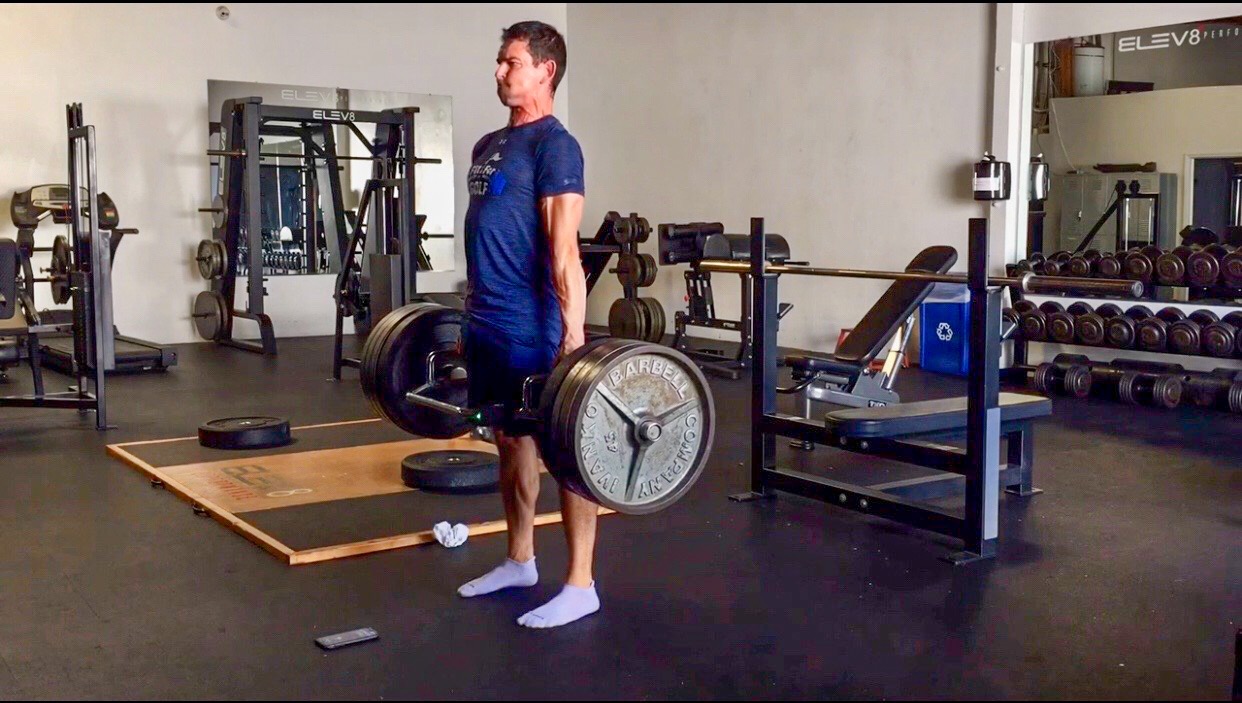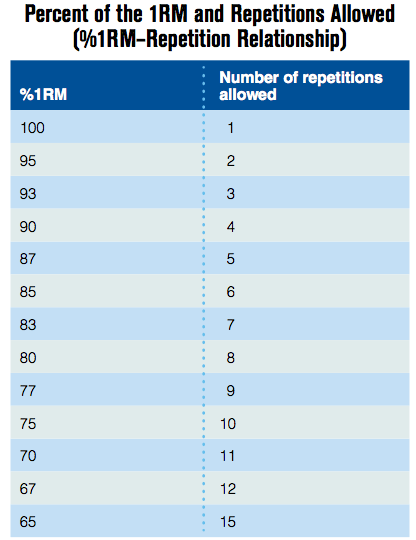IMPROVE MY GAME
Articles
“Heavy” Strength Training – What’s The Point?

Golf clubs are light and one of the main training goals for many golfers is to be able to swing them faster.
How does heavy strength training help with this?
For the purpose of this article I’m going to define “heavy” as a load (resistance) that you can only move a maximum of 8 times in one set before failure. This will be the equivalent of approximately 80% of your one repetition maximum (1RM) – The most weight you can successfully lift for one rep in a given exercise . For different exercises and different strength levels that actual load will be vastly different, but it’s all relative. “Heavy” is different for everyone.
Here’s a chart that shows the approximate repetitions possible in a set before failure. This is a rough guide and will vary a lot for different people and different exercises. To be optimally training strength we need to be using weights / resistances that are above 80% of our 1RM.

Chart from “The Essentials Of Strength Training & Conditioning”
Heavy strength training is an important inclusion in the physical training plan of golfers who want to increase club head speed for a few key reasons.
1) Improved Motor Unit Recruitment:
This means it teaches our Central Nervous System (CNS) how to tap into all of our available muscle fibers. The hardest ones to activate and train are our biggest and fastest ones known as the type 2x or fast twitch fibers. If you’re not training with maximal intent in your movements, you do not train these fibers. This is a huge missing element for those who only do cardio or exclusively slow tempo resistance training.
Heavy strength training is the best tool we have for improving Motor Unit Recruitment. When using heavy loads relative to our strength level, we are forced to push as hard as possible and recruit as many of our muscle fibers as possible, otherwise we cannot execute the rep successfully.
This is one of the main ways people get stronger without any increase in muscle size. They get better at recruiting fast twitch fibers they already have, but never learned to use.
Key note: The intent to perform each rep with as much force as possible opposed to just using as much force as necessary to complete the rep in the “lifting phase” is essential for training progress. You may actually be moving slowly because the weight is heavy relative to your strength level, but the intent to move the bar / implement as quickly as possible is key. “Drive the bar through the ceiling” is a good cue for most people to think of when performing a rep on the bench press or squat for example.
2) Increased Maximum Force Production Capabilities:
Power in the golf swing is the ability to apply high amounts of force in a small time frame. Think of force as strength. The golf swing takes approximately 1 second. The back swing takes 0.75 seconds and the downswing takes 0.25 seconds (varies from player to player, but this is close enough for the purpose of evaluating how to train).
To produce high levels of force in this small time frame first requires the ability to produce a lot of force. If your strength levels are low, you have a low ceiling for force production. In fast movements with light resistance we do not have time to access all of our strength. The movement happens too quickly, so we only get to apply a certain % of our strength. If we only get to apply a certain % of our strength during the golf swing, and our strength levels are low, there will not be a lot of force applied. If strength levels are higher you are applying the same %, but from a larger base. We want a large force ceiling to draw from rather than a small one.
Hypothetically, if a golfer gets to apply for example 25% of their strength during the golf swing, you want to be applying 25% of a high strength level rather than a low one. (This is an extremely simplified explanation, there are many other factors in play).
This is a key differential between understanding strength vs speed & power. Strength is maximum force production with no time constraints. Think of a very high heavy lift that is moving extremely slowly, or pushing something you cannot move. You have as much time as necessary to produce all the force you are capable of. The golf swing happens too quickly to be able to apply all of our force production capability aka strength. If our strength is low to begin with, and we only get to apply a certain % of your strength in the swing, we want to be pulling from a large strength pool rather than a small one. This is one of the main reasons why when someone begins strength training, their speed increases. They are tapping into a larger strength base.
Another analogy I use for this is acceleration and top speed in cars. Think of top speed as strength, and 0-60mph time as power. Cars with low top speed levels don’t go from 0-60mph quickly. There’s not enough margin between 60mph and their maximum speed. It’s the cars with a very high top speed (akin to force or strength ceiling) go from 0-60mph quickly. Bringing this back to golf, don’t expect to be able to swing fast, if strength levels are low.
3) Hypertrophy / Increasing Muscle Size:
Bigger muscle fibers, especially type 2 / fast twitch fibers make it easier to produce force at all velocities and in all time frames. This is extremely valuable for golfers. Unlike running and jumping sports, golfers do not need to propel their body weight and worry about extra mass “slowing them down”. This is one of the reasons why Track & Field sprinters and jumpers have very different body masses to throwers. Gaining muscle mass can be detrimental for sprinters and jumpers as they need to project their mass, but this is not the case for golfers. We’re trying to impart as much force as possible on an external object, and extra mass generally helps with this. Especially when the extra mass is muscle tissue and contributes to strength & power.
Increasing body mass aka being heavier will also likely enhance ground force – which is a key characteristic for club head speed.
Light weight high speed training while essential in the training program, does not lead to significant increases in muscle size. The main priorities when training for muscle size is a combination of motor unit recruitment & mechanical loading. This occurs when we are straining against something as hard as we can, but the movement speed is very slow. This is not the same as intentionally using slow tempos. You need to be trying to move the load as quickly as possible
(in the upward phase) but due to either the weight being heavy when performing low reps, or as you fatigue when performing medium and higher reps (eg 8-12 rep sets that reach failure).
An advantage for golfers in using heavier weights and lower reps for enhancing muscle size is that it will lead to greater strength and power gains than the same increases in muscle size compared to using lighter weight and medium / high reps. This is because the force production required for heavier weights is greater than the force production required to move lighter weights when fatigued even though the effort level might feel the same.
For example there’s far more force being produced during the last rep of a 5 rep max squat compared to a 12 rep max squat even though the last rep on each set may feel just as difficult. (The weight used for a 5 rep max will be much heavier than a 12 rep max. More weight requires more force production)
4) Makes Power & Speed Training More Effective:
Athletes with high strength levels respond better to power & speed training. As explained earlier, when strength levels are low you cannot produce high amounts of force. In this scenario if you only train to learn how to apply force more quickly as opposed to training to increase how much force you can produce your results will be far from optimal.
Improvements in coordination may lead to rapid short term improvements but you will likely plateau much faster and at a lower level than if you were training to enhance both simultaneously. This is one of the reasons why I think the very popular SuperSpeed Golf speed stick training should be part of an overall strength and conditioning program, rather than THE program.
Who do you think has more potential for long term speed improvement? The golfer who only practices swinging faster and faster with speed training or the golfer who practices swinging faster and faster whilst also increasing strength, power, and muscle mass?
The answer is of course the second golfer. The second golfer will also be less likely to get injured as his body will be better able to tolerate the extremely high stress levels of maximal speed golf swings.
5) Injury Prevention:
When swinging golf clubs at maximum speed, especially for high volumes, having a healthy amount of muscle mass, muscle strength, and general muscle conditioning will make your body far more resilient and better at tolerating these stresses. Managing practice and play volumes i.e how many balls you’re hitting, strength training, and adequate sleep are the best tools we have for injury prevention.
Hold On…..It’s Not Just About Strength!
Hopefully I have made it clear why heavy strength training is an important consideration for golfers. Something I want to make very clear is that stronger is not always better or worth the training time, effort, and opportunity cost however.
In the beginning stages of training, strength gains come quite rapidly and they are quite large in magnitude. The transfer from heavy strength training to light weight high velocity movements like the golf swing is also quite clear. This is especially evident in approximately the first year of training.
As you advance in your training however, to continue gaining strength becomes much harder, and requires far more strenuous training protocols. The transfer we derive from increases in strength to light high velocity movements like the golf swing also start to diminish. The reason for this is that the more advanced we get in our training, the more specific to the sporting action it must be to continue transferring. While heavy strength training is useful and beneficial, it is also a lot different to swinging a light golf club at maximum speed. This may become evident in the 2nd or 3rd year of consistent strength training, but will be different for everyone.
We are then in a position when we must consider if the strenuous training protocols and fatigue built up as a result required to keep enhancing strength are worth the benefits we get from increased strength.
At this point if we want to keep training to enhance club head speed a shift in training emphasis may be beneficial. Rather than prioritising lifting heavier and heavier loads as a sign of training progress, we can start to emphasise training exercises and programs that focus more on moving moderate and light implements at higher velocities in movements that more closely resemble the swing, or key power elements of the swing.
Different types of jumping, medicine ball throws, dynamic cable pulley & band exercises, and various swing drills (including weighted and overspeed) are examples of this.
During this time it is important to not completely ditch strength training as a decline in strength levels may be detrimental (remember the idea of drawing from as high a strength ceiling as possible). Very low training volumes can be used to successfully maintain strength compared to the volumes needed to enhance them in trained individuals however, so you could substantially cut strength training volume and frequency and still maintain strength.
In summary – When untrained individuals begin strength training they will see huge increases in club head speed from improving strength levels.
The more and more advanced we get in our strength training the harder it is to keep improving strength, and more strenuous strength training protocols are required. The transfer to club head speed we will get from this enhanced strength will also begin to decline.
This is when more specialised and specific training protocols which emphasise movement patterns and velocities present in the swing will become important if the golfer wants to continue improving club head speed.
Some golfers already do highly specific speed work in their golf practice, by hitting drivers as hard as they can. The more of this you do, the less specific speed work you will require in the gym, and the more you will likely benefit from enhancing strength and power qualities. This is essentially increasing your horsepower. College and Professional players are good examples of this.
My programming generally provides a blend of:
-Heavy strength work (heavy is relative to the individuals strength level and means very different things)
-Light & Medium weight high velocity power work
-Sport specific speed – swinging clubs / sticks as fast as you can
-Some medium to high rep strength resistance training to support increasing muscle size, general muscle conditioning, and injury prevention.
The emphasis in training can be altered depending on the training level, training history, and needs of the golfer.
Ask yourself where you fall in this training continuum of beginner to advanced and how much general vs specific training you need to move closer to your potential.

Mike Carroll has a BSc in Sport & Exercise Science from the University of Limerick, and is an accredited S&C Coach with the UK strength and Conditioning Association and TPI Fitness Level 3 Certified. He works with golfers of all levels - from juniors to professional golfers - via the Fit For Golf app.
Twitter: @fit_for_golf
Facebook: Fit For Golf Cork